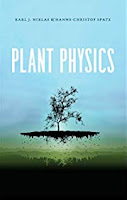 |
| Plant Physics, by Karl Niklas and Hans-Christof Spatz. |
This book has two interweaving themes—one that emphasizes plant biology and another that emphasizes physics. For this reason, we have called it Plant Physics. The basic thesis of our book is simple: plants cannot be fully understood without examining how physical forces and processes influence their growth, development, reproduction, and evolution….This book explores…many…insights that emerge when plants are studied with the aid of physics, mathematics, engineering, and chemistry. Much of this exploration dwells on the discipline known as solid mechanics because this has been the focus of much botanical research. However, Plant Physics is not a book about plant solid mechanics. It treats a wider range of phenomena that traditionally fall under the purview of physics, including fluid mechanics, electrophysiology, and optics. It also outlines the physics of physiological processes such as photosynthesis, phloem loading, and stomatal opening and closing.The chapter titles in Plant Physics overlap with topics in IPMB, such as Chapter 4 (The Mechanical Behavior of Materials), Chapter 6 (Fluid Mechanics), and Chapter 7 (Plant Electrophysiology). I found the mathematical level of the book to be somewhat lower than IPMB, and probably closer to Denny’s Air and Water. (Interestingly, they did not cite Air and Water in their Section 2.3, Living in Water Versus Air, but they do cite another of Denny’s books, Biology and the Mechanics of the Wave-Swept Environment.) The differences between air and water plays a key role in plant life: “It is very possible that the colonization of land by plant life was propelled by the benefits of exchanging a blue and often turbid liquid for an essentially transparent mixture of gasses.” The book discusses diffusion, the Reynold’s number, chemical potential, Poiseuille flow, and light absorption. Chapter 3 is devoted to Plant Water Relations, and contains an example that serves as a model for how physics can play a role in biology. The opening and closing of stomata (“guard cells”) in leaves involves diffusion, osmotic pressure, feedback, mechanics, and optics. Fluid flow through both the xylem (transporting water from the roots to the leaves) and phloem (transporting photosynthetically produced molecules from the leaves to the rest of the plant) are discussed. Biomechanics plays a larger role in Plant Physics than in IPMB, and at the start of Chapter 4 the authors explain why.
The major premise of this book is that organisms cannot violate the fundamental laws of physics. A corollary to this premise is that organisms have evolved and adapted to mechanical forces in a manner consistent with the limits set by the mechanical properties of the materials out of which they are constructed…We see no better expression of these assertions that when we examine how the physical properties of different plant materials influence the mechanical behavior of plants.Russ and I discuss Poisson’s ratio in a homework problem in Chapter 1. Niklas and Spatz give a nice example of how a large Poisson’s ratio can arise when a cylindrical cell has inextensible fibers in its cell wall that follow a spiral pattern.
Values [of the Poisson’s ratio] can be very different [from isotropic materials] for composite biological materials such as most tissues, for which Poisson’s ratios greater than 1.0 can be found. A calculation presented in box 4.2 shows that in a sclerenchyma cell, in which practically inextensible cellulose microfibers provide the strengthening material in the cell wall, the Poisson’s ratio strongly depends on the microfibrillar angle; that is, the angle between fibers and the longitudinal axis of the cell.Given my interest in bioelectric phenomena, I was especially curious about the chapter on Plant Electrophysiology (Chapter 7). The authors derive the Nernst-Planck equation, and the Goldman equation for the transmembrane potential. Interestingly, plants contain potassium and calcium ion channels, but no sodium channels. Many plants have cells that fire action potentials, but the role of the sodium channel for excitation is replaced by a calcium-dependent chloride channel. These are slowly propagating waves; Niklas and Spatz report conduction velocities of less than 0.1 m/s, compared to propagation in a large myelinated human axon, which can reach up to 100 m/s. Patch clamp recordings are more difficult in plant than in animal cells (plants have a cell wall in addition to a cell membrane). Particularly interesting to me were the gravisensitive currents in Lepidium sativum roots. The distribution of current is determined by the orientation of the root in a gravitational field.
Botanists need physics just as much as zoologists do. Plants are just one more path leading from physics to biology.
For those wanting to learn more, my colleague at Oakland University, Steffan Puwal, plans to offer a course in Plant Physics in the winter 2015 semester.



No comments:
Post a Comment